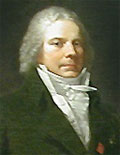 |
Charles-Maurice de Talleyrand-Périgord
b. 2 Feb 1754, Paris
d. 17 May 1838, Paris |
| Title: |
Membre du Gouvernement provisoire (Member of the Provisional Government) |
| Term: |
1 Apr 1814 - 14 Apr 1814 |
| Chronology: |
1 Apr 1814, appointed, act of the Sénat conservateur [1][2] |
|
14 Apr 1814, provisional government conferred on the Lieutenant général du royaume (Lieutenant General of the Kingdom), resolution of the Sénat conservateur [3][4] |
| Names/titles: |
Évêque d'Autun [bishop of Autun] (17 Jan 1788 - 20 Jan 1791, resignation dated 13 Jan 1791); prince souverain de Bénévent [sovereign prince of Benevento] (5 Jun 1806 - 4 Jun 1815); prince de Talleyrand [prince of Talleyrand] (4 Jun 1815 - 31 Aug 1817); duc de Talleyrand [duke of Talleyrand] (from 31 Aug 1817); duc de Dino, duca di Dino [duke of Dino, in the Kingdom of the Two Sicilies] (from 2 Dec 1817); |
| |
Président de l'Assemblée nationale (President of the National Assembly) (16 Feb 1790 - 28 Feb 1790) [see details] |
| Biography: |
| Descendant of a noble family of Quercy, second son of Charles-Daniel comte de Talleyrand-Périgord, lieutenant-general in the royal army; educated at the Collège d'Harcourt (1762-1770) and the seminary of Saint-Sulpice in Paris (1770-1775); nominated abbot of Saint-Rémi-de Reims (1775); received a degree (1778) in theology from the Sorbonne; ordained priest (1779); named agent general of the Assembly of the Clergy (1780-1785); appointed bishop of Autun (17 Jan 1788 - 20 Jan 1791); elected (3 Apr 1789) as a representative of the clergy of Autun to the États-Généraux (Estates-General); joined the sessions of the Third Estate (21 Jun 1789) as a deputy of the Assemblée nationale (National Assembly) (1789-1791); elected President of the National Assembly (16 Feb 1790 - 28 Feb 1790); urged the repeal of the tithe and the nationalization of church property; took the oath of loyalty to the Civil Constitution of the Clergy (27 Dec 1790); was excommunicated by the Pope (1791); elected administrator of the département of Paris (1791); sent on a diplomatic mission to London (1792); denounced (5 Dec 1792) by the Convention nationale (National Convention) as a royalist supporter; lived in England (1792-1794) and the United States (1794-1796); on return to France, was appointed minister for external affairs (16 Jul 1797 - 20 Jul 1799); again appointed minister for external affairs by Napoléon Bonaparte (22 Nov 1799 - 9 Aug 1807); relieved of his ecclesiastical obligations by the letter of Pope Pius VII (29 Jun 1802); was instrumental in implementing Napoléon's foreign policy in Europe, but opposed wars against Austria, Prussia, and Russia; appointed grand chamberlain (11 Jul 1804); created sovereign prince of Benevento (5 Jun 1806 - 4 Jun 1815); negotiated the treaties of Pressburg (1805) and of Tilsit (1807); appointed grand vice elector (9 Aug 1807); split with Napoléon and was stripped of the title of grand chamberlain (29 Jan 1809); entered the negotiations with the Allied Powers on the eve of Napoléon's first abdication; nominated a member of the Provisional Government (1 Apr 1814); appointed minister and secretary of state for foreign affairs (13 May 1814 - 20 Mar 1815) during the First Restoration; created prince of Talleyrand and a peer of France (4 Jun 1814); participated in the Congress of Vienna (1814) and obtained restoration of the frontiers of 1792 for France; appointed president of the Council of Ministers (9 Jul 1815 - 26 Sep 1815) and minister for foreign affairs (9 Jul 1815 - 24 Sep 1815); named minister of state and grand chamberlain (28 Sep 1815); created duke of Talleyrand (31 Aug 1817) and was granted the title of duke of Dino by the King of the Two Sicilies (2 Dec 1817); served as ambassador of France to Great Britain (1830-1834).
Biography source: [5][6] |
| |
| [1] |
Archives parlementaires. Série 2, vol. XII, pp. 7-8. |
| [2] |
Bulletin des lois, № 1: № 1 - Acte du Sénat qui nomme un Gouvernement provisoire chargé de pourvoir aux besoins de l'administration et de présenter au Sénat un projet de constitution, in "Bulletin des lois du Royaume de France", 5e série, Tome premier, contenant les Lois pendant le second trimestre de l'année 1814 (Paris: Imprimerie royale, Septembre 1814), pp. 1-3, 35 (errata). |
| [3] |
Archives parlementaires, op. cit., vol. XII, p. 17. |
| [4] |
Bulletin des lois, № 3: № 43 - Décret du Sénat, qui défère le gouvernement provisoire de la France à S.A.R.M.gr le Comte d' Artois, sous le titre de Lieutenant général du royaume, in "Bulletin des lois du Royaume de France", 5e série, Tome premier, contenant les Lois pendant le second trimestre de l'année 1814 (Paris: Imprimerie royale, Septembre 1814), pp. 41-42. |
| [5] |
Dictionnaire des parlementaires français 1789-1889, |
| [6] |
"Talleyrand", by Philip G. Dwyer (Edinborough: Pearson Education, 2002). |
|
Image: portrait by Pierre-Paul Prud'hon (1817). |